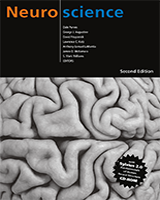By agreement with the publisher, this book is accessible by the search feature, but cannot be browsed.
NCBI Bookshelf. A service of the National Library of Medicine, National Institutes of Health.
Purves D, Augustine GJ, Fitzpatrick D, et al., editors. Neuroscience. 2nd edition. Sunderland (MA): Sinauer Associates; 2001.

Neuroscience. 2nd edition.
Show detailsOverview
The generation of electrical signals in neurons requires both selective membrane permeability and specific ion concentration gradients across the plasma membrane. The membrane proteins that give rise to selective permeability are called ion channels, whereas other proteins called active transporters create and maintain ion gradients. As their name implies, ion channels have pores that permit particular ions to cross the neuronal membrane. Some of these channels are also able to sense the electrical potential across the membrane. Such voltage-gated channels open or close in response to the magnitude of the membrane potential, allowing the membrane permeability to be regulated by the potential. Some ion channels are gated by extracellular chemical signals such as neurotransmitters, others by intracellular signals such as second messengers, and still others respond to mechanical stimuli or temperature changes. Many types of ion channels have now been identified at the molecular level, and this diversity generates a wide spectrum of electrical characteristics among neuron types. In contrast to the functions of ion channels, active transporters are membrane proteins that produce and maintain ion concentration gradients. The most important of these is the Na+ pump, which hydrolyzes ATP to regulate the intracellular concentrations of both Na+ and K+. Other active transporters produce concentration gradients for the full range of physiologically important ions, including Cl-, Ca2+, and H+. From the perspective of electrical signaling, active transporters and ion channels are complementary: Transporters create the concentration gradients that drive ions through open ion channels, thus generating electrical signals.
- Ion Channels Underlying Action Potentials
- The Diversity of Ion Channels
- Voltage-Gated Ion Channels
- Ligand-Gated Ion Channels
- Stretch- and Heat-Activated Channels
- The Molecular Structure of Ion Channels
- Active Transporters Create and Maintain Ion Gradients
- Functional Properties of the Na+/K+ Pump
- The Molecular Structure of the Na+/K+ Pump
- Summary
- Additional Reading
- Channels and Transporters - NeuroscienceChannels and Transporters - Neuroscience
- LOC115162102 [Salmo trutta]LOC115162102 [Salmo trutta]Gene ID:115162102Gene
Your browsing activity is empty.
Activity recording is turned off.
See more...